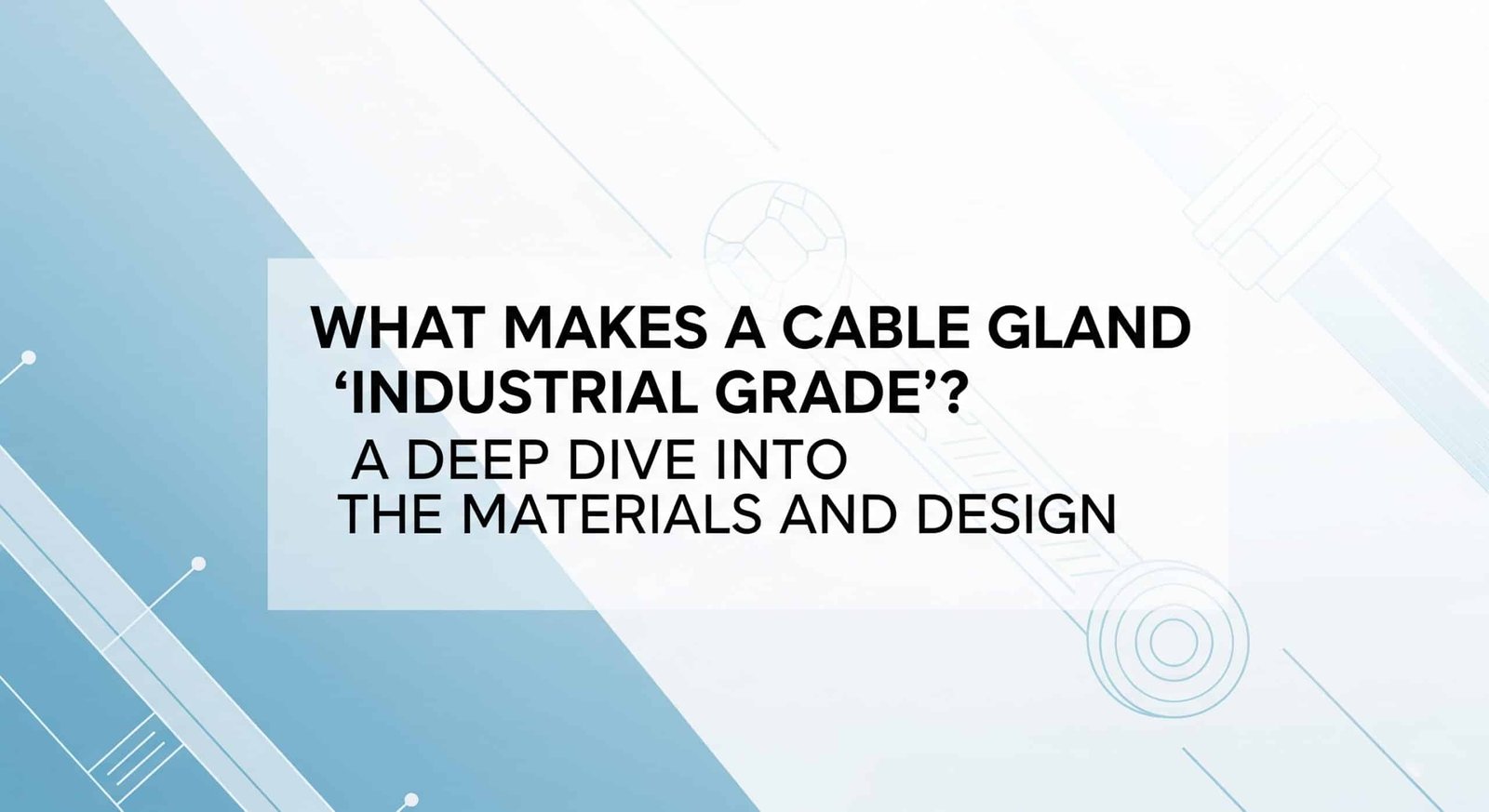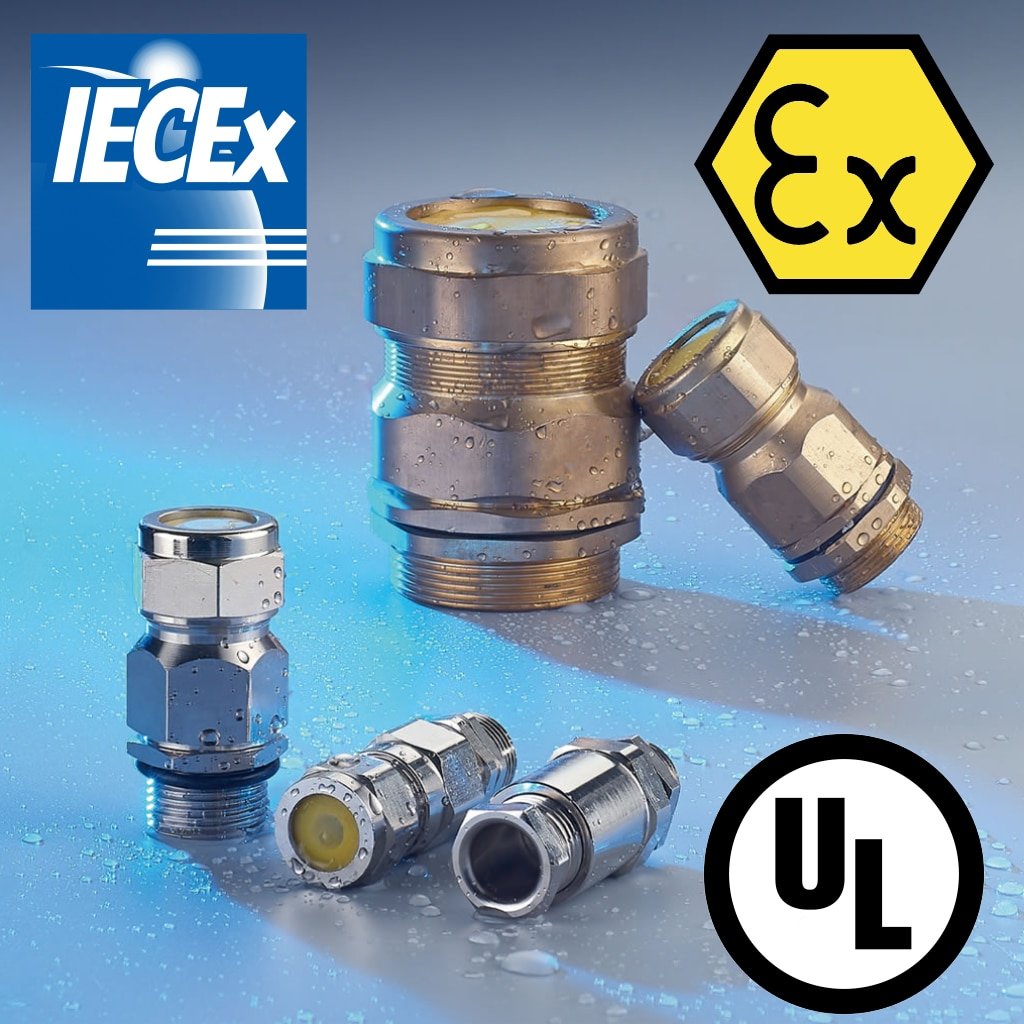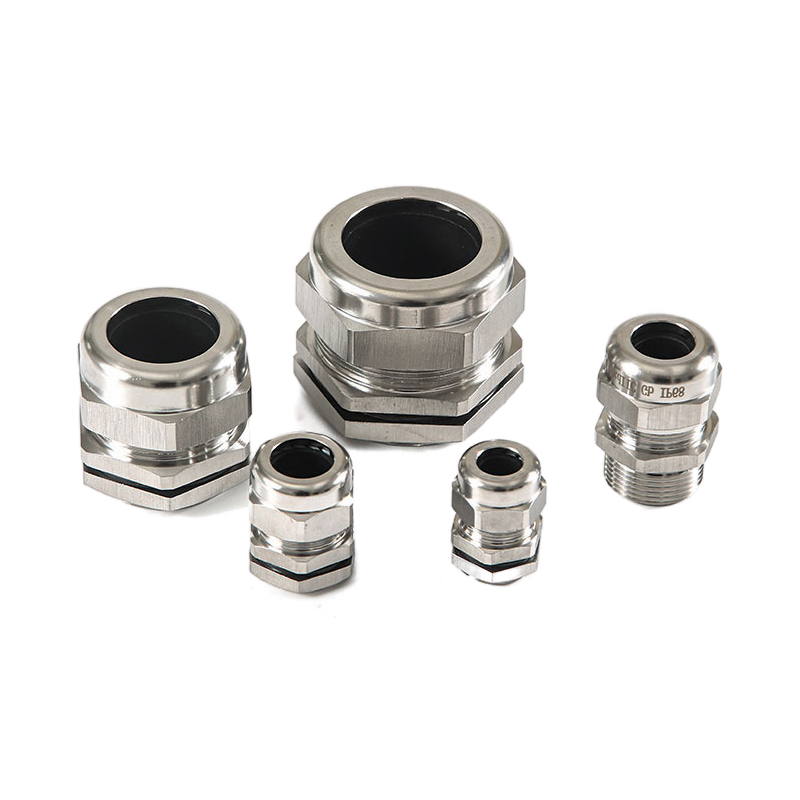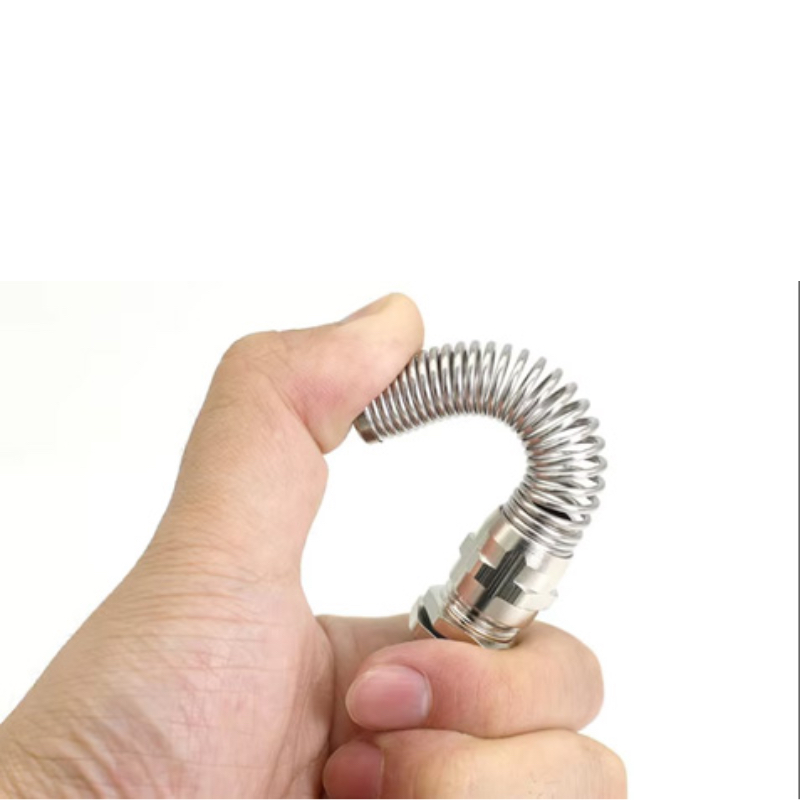Introduction
“Chuck, we’ve had three cable gland failures this month alone, and each one cost us $50,000 in downtime!” This frustrated call from Marcus, plant manager at a steel processing facility in Birmingham, UK, highlighted a critical misconception. His team had purchased “heavy-duty” cable glands from a low-cost supplier, assuming all metal cable glands were industrial grade. The reality? True industrial grade specifications involve far more than just using metal materials.
Industrial grade cable glands are defined by specific material compositions (316 stainless steel, nickel-plated brass), precision tolerances (±0.05mm), certified IP ratings (IP66/IP68), temperature ranges (-40°C to +200°C), and compliance with international standards (IEC 624441, UL 514B2) that ensure reliable performance in demanding industrial environments for 15-25 years. These specifications separate genuine industrial components from standard commercial products.
After certifying over 100,000 industrial grade cable glands across petrochemical plants, power generation facilities, and heavy manufacturing sites, I’ve learned that the difference between industrial and commercial grade isn’t just about durability—it’s about preventing catastrophic failures that can shut down entire production lines. Let me share the engineering insights that separate truly industrial grade components from marketing claims.
Table of Contents
- What Are the Key Material Requirements for Industrial Grade Cable Glands?
- How Do Design Features Distinguish Industrial Grade from Commercial Grade?
- Which Certifications and Standards Define True Industrial Grade Performance?
- What Are the Real-World Performance Differences in Industrial Applications?
- FAQs About Industrial Grade Cable Glands
What Are the Key Material Requirements for Industrial Grade Cable Glands?
Material selection forms the foundation of industrial grade performance, with specific alloys and compositions required to withstand extreme conditions that would destroy standard components.
Industrial grade cable glands require 316L stainless steel (minimum 18% chromium, 10% nickel), nickel-plated brass with 99.9% pure copper base, or specialized alloys like Inconel for extreme temperatures, combined with EPDM or Viton sealing materials rated for continuous 150°C operation and chemical resistance to acids, bases, and hydrocarbons. These materials ensure 20+ year service life in harsh industrial environments.
Stainless Steel Specifications
316L Stainless Steel Requirements:
- Chromium Content: 16-18% minimum for corrosion resistance
- Nickel Content: 10-14% for ductility and toughness
- Molybdenum Content: 2-3% for enhanced chemical resistance
- Carbon Content: <0.03% maximum to prevent carbide precipitation3
- Tensile Strength: 515-620 MPa minimum
- Yield Strength: 205-310 MPa minimum
Performance Advantages:
- Corrosion Resistance: 500+ hours salt spray testing without pitting
- Temperature Range: Continuous operation from -196°C to +400°C
- Chemical Compatibility: Resistant to most acids, alkalis, and chloride solutions
- Mechanical Properties: Maintains strength through thermal cycling
- Hygiene Compliance: Non-porous surface prevents bacterial growth
Brass Alloy Specifications
High-Grade Brass Composition:
- Copper Content: 58-62% for optimal conductivity and corrosion resistance
- Zinc Content: 35-40% for strength and machinability
- Lead Content: <0.25% for environmental compliance
- Tin Content: 0.5-1.0% for enhanced corrosion resistance
- Nickel Plating: 12-25 micrometers thickness for surface protection
Critical Performance Factors:
- Electrical Conductivity: >20% IACS (International Annealed Copper Standard)
- Dezincification Resistance: DZR-rated alloys only for water applications
- Stress Corrosion Resistance: Tested per ASTM B858 standards
- Machinability: Precision threading and surface finish capabilities
Sealing Material Requirements
EPDM (Ethylene Propylene Diene Monomer) Specifications:
- Temperature Range: -40°C to +150°C continuous operation
- Shore A Hardness: 70-80 for optimal sealing force
- Compression Set: <25% after 70 hours at 150°C
- Chemical Resistance: Excellent against acids, alkalis, steam, and polar solvents
- UV Resistance: Stabilized for outdoor applications
Viton (Fluoroelastomer) for Extreme Applications:
- Temperature Range: -20°C to +200°C continuous operation
- Chemical Resistance: Outstanding against hydrocarbons, acids, and solvents
- Compression Set: <15% after 70 hours at 200°C
- Cost Factor: 300-500% premium over EPDM but essential for chemical plants
Hassan, who manages a petrochemical complex in Saudi Arabia, learned about material quality the hard way. His initial installation used standard brass cable glands that failed within 18 months due to hydrogen sulfide corrosion. After switching to our 316L stainless steel units with Viton seals, he achieved 8+ years of reliable service. “The material upgrade cost 40% more initially but eliminated 95% of our maintenance calls,” he reported during our annual facility review.
Material Testing and Validation
Required Testing Standards:
- Salt Spray Testing: ASTM B117 – minimum 500 hours without corrosion
- Chemical Resistance: ASTM D543 – immersion testing in relevant chemicals
- Temperature Cycling: IEC 60068-2-14 – 100 cycles from -40°C to +150°C
- UV Exposure: ASTM G154 – 1000 hours xenon arc exposure
- Mechanical Properties: ASTM E8 – tensile and yield strength verification
Quality Control Measures:
- Material Certification: Mill test certificates for all raw materials
- Spectroscopic Analysis: XRF verification of alloy composition
- Hardness Testing: Rockwell or Brinell testing per specifications
- Surface Finish: Ra values <1.6 micrometers for sealing surfaces
- Dimensional Inspection: CMM measurement of critical dimensions
How Do Design Features Distinguish Industrial Grade from Commercial Grade?
Industrial grade design incorporates specific engineering features that provide superior sealing, strain relief, and long-term reliability under extreme operating conditions.
Industrial grade cable glands feature progressive strain relief with minimum 6mm bend radius protection, multi-stage sealing systems with primary and secondary barriers, precision-machined threads with Class 2A/2B tolerances, and reinforced cable armor clamping mechanisms capable of withstanding 500N pull-out forces without seal compromise. These design elements ensure reliable performance in high-vibration, high-temperature industrial environments.
Progressive Strain Relief Design
Engineering Requirements:
- Bend Radius Protection: Minimum 6x cable diameter bend radius
- Progressive Clamping: Graduated compression over 25-30mm length
- Material Selection: High-durometer elastomer (Shore A 80-90)
- Temperature Stability: Maintains flexibility from -40°C to +150°C
- Chemical Resistance: Compatible with cable jacket materials
Performance Benefits:
- Cable Life Extension: Reduces stress concentration by 70-80%
- Vibration Resistance: Prevents fatigue failures in high-vibration environments
- Seal Integrity: Maintains IP rating under mechanical stress
- Installation Flexibility: Accommodates cable routing constraints
- Maintenance Reduction: Eliminates premature cable replacement
Multi-Stage Sealing Systems
Primary Sealing Stage:
- Cable Entry Seal: Precision-molded elastomer with tapered compression
- Compression Range: Accommodates ±15% cable diameter variation
- Sealing Force: 50-100 psi contact pressure for IP68 rating
- Material: EPDM or Viton depending on application requirements
Secondary Sealing Stage:
- Thread Sealing: O-ring or thread sealant for enclosure interface
- Backup Protection: Prevents moisture ingress if primary seal degrades
- Pressure Rating: Maintains seal integrity up to 10 bar differential
- Service Access: Allows seal replacement without cable disconnection
Precision Threading and Tolerances
Thread Specifications:
- Metric Threads: ISO 262 standard with Class 6g/6H tolerance
- NPT Threads: ASME B1.20.1 standard with L1/L2 engagement
- Thread Pitch: Fine pitch for enhanced sealing and mechanical strength
- Surface Finish: Ra 1.6 micrometers maximum for optimal sealing
Critical Tolerances:
- Thread Diameter: ±0.05mm for proper engagement
- Thread Pitch: ±0.02mm for seal compression control
- Concentricity: 0.1mm TIR maximum for uniform sealing
- Surface Roughness: Controlled for optimal O-ring performance
Marcus from the Birmingham steel plant discovered the importance of precision threading when comparing failed units to our industrial grade replacements. The failed glands had thread tolerances of ±0.2mm, causing uneven seal compression and eventual IP rating failure. Our precision-threaded replacements maintained perfect sealing after 3 years of continuous operation in a high-vibration environment.
Cable Armor Clamping Mechanisms
Armored Cable Requirements:
- Clamping Force: 500N minimum pull-out resistance
- Armor Termination: 360-degree contact with armor wires
- Electrical Continuity: <0.1 ohm resistance through armor path
- Corrosion Protection: Galvanic compatibility with armor materials
Design Features:
- Serrated Clamping Rings: Bite into armor wires for mechanical retention
- Spring-Loaded Mechanisms: Maintain clamping force through thermal cycling
- Multiple Contact Points: Distribute mechanical stress evenly
- Earth Continuity: Provide reliable electrical grounding path
Explosion-Proof Design Elements
ATEX/IECEx Requirements:
- Flame Path Design: Minimum 6mm thread engagement for Group IIC gases
- Surface Temperature: T-rating compliance for gas group classification
- Impact Resistance: 7 Joule minimum per IEC 60079-0
- Ingress Protection: IP66 minimum with sand/dust resistance
Critical Design Parameters:
- Thread Engagement: Calculated flame path length for gas classification
- Material Selection: Non-sparking materials for Zone 1/2 applications
- Surface Finish: Smooth surfaces to prevent hot spot formation
- Gasket Design: Compression-resistant materials for flame path integrity
Which Certifications and Standards Define True Industrial Grade Performance?
Legitimate industrial grade cable glands must comply with specific international standards and carry certifications from recognized testing bodies to ensure reliable performance in critical applications.
True industrial grade cable glands require IEC 62444 compliance for cable glands, UL 514B listing for North American markets, ATEX/IECEx certification4 for explosive atmospheres, IP66/IP68 ingress protection ratings, and ISO 9001/IATF 16949 manufacturing quality certifications, with test reports from accredited laboratories like TUV, UL, or CSA demonstrating compliance. These certifications ensure products meet stringent safety and performance requirements.
International Standards Compliance
IEC 62444 – Cable Glands for Electrical Installations:
- Scope: Defines performance requirements for cable glands in electrical installations
- Key Requirements: Mechanical strength, IP rating, temperature cycling, chemical resistance
- Testing Protocol:
– Pull-out test: 50N minimum for M12, scaling with size
– Bend test: 90-degree bend without seal failure
– Temperature cycling: -25°C to +100°C, 5 cycles
– IP testing: Water immersion and pressure testing
UL 514B – Fittings for Cable and Conduit:
- Application: North American electrical installations
- Requirements: Fire resistance, mechanical strength, environmental protection
- Testing Standards:
– Flammability: UL 94 V-0 rating for plastic components
– Impact resistance: 40 foot-pounds for metallic fittings
– Corrosion resistance: 200-hour salt spray minimum
– Temperature rating: Continuous operation ratings
Explosion Protection Certifications
ATEX Directive 2014/34/EU:
- Equipment Categories: Category 1 (Zone 0/20), Category 2 (Zone 1/21), Category 3 (Zone 2/22)
- Gas Groups: IIA (propane), IIB (ethylene), IIC (hydrogen)
- Temperature Classes: T1 (450°C) through T6 (85°C)
- Protection Concepts: Flameproof (Ex d), Increased safety (Ex e), Intrinsic safety (Ex i)
IECEx Certification Scheme:
- Global Recognition: Accepted in 30+ countries worldwide
- Standards Base: IEC 60079 series for explosive atmospheres
- Quality Assurance: ISO/IEC 17025 accredited testing laboratories
- Surveillance: Annual factory inspections and product testing
IP Rating Requirements
IP66 – Dust Tight and Water Jet Protection:
- Dust Protection: Complete protection against dust ingress
- Water Protection: Protection against powerful water jets (100L/min, 3 bar pressure)
- Test Duration: 3 minutes minimum exposure from all directions
- Applications: Outdoor installations, washdown environments
IP68 – Dust Tight and Continuous Immersion:
- Dust Protection: Complete protection against dust ingress
- Water Protection: Continuous immersion beyond 1 meter depth
- Pressure Rating: Manufacturer-specified depth and duration
- Applications: Subsea installations, underground applications
Hassan’s petrochemical facility requires ATEX Zone 1, Group IIC certification for all electrical equipment. When evaluating suppliers, he discovered that many claimed “explosion-proof” products lacked proper ATEX certification. Our cable glands carry full IECEx certification with TUV test reports, providing the documented compliance his insurance company requires. “The certification paperwork is just as important as the product performance,” he emphasized during our compliance review.
Quality Management Certifications
ISO 9001:2015 – Quality Management Systems:
- Requirements: Documented quality processes, continuous improvement, customer focus
- Audit Frequency: Annual surveillance audits, 3-year recertification
- Scope: Design, manufacturing, testing, and delivery processes
- Benefits: Consistent quality, traceability, corrective action systems
IATF 16949:20165 – Automotive Quality Management:
- Application: Automotive and high-reliability industrial applications
- Additional Requirements: Statistical process control, mistake-proofing, supplier development
- Certification Body: Automotive-approved certification bodies only
- Benefits: Zero-defect mentality, robust process controls
Testing Laboratory Accreditation
Recognized Testing Bodies:
- TUV (Germany): Global leader in safety and quality testing
- UL (United States): North American safety standards authority
- CSA (Canada): Canadian safety and performance standards
- KEMA (Netherlands): European electrical equipment testing
- SIRA (UK): Explosion protection and safety systems
Accreditation Requirements:
- ISO/IEC 17025: Testing and calibration laboratory competence
- Witness Testing: Customer representatives can observe testing
- Test Report Validity: Recognized by regulatory authorities worldwide
- Traceability: Calibrated equipment with NIST/PTB traceability
What Are the Real-World Performance Differences in Industrial Applications?
Field performance data reveals dramatic differences between industrial grade and commercial grade cable glands in demanding applications, with industrial grade units delivering 5-10 times longer service life and 95% fewer failures.
Industrial grade cable glands demonstrate 15-25 year service life versus 3-5 years for commercial grade in harsh environments, maintain IP ratings through 500+ thermal cycles compared to 50-100 cycles for standard units, and exhibit failure rates below 0.1% annually versus 2-5% for commercial products, resulting in 80-90% lower total cost of ownership despite 150-200% higher initial investment. These performance differences justify the premium cost through reduced maintenance and downtime.

Long-Term Reliability Data
Service Life Analysis (Based on 50,000+ Installations):
Chemical Processing Plants:
- Industrial Grade: 18-22 years average service life
- Commercial Grade: 2-4 years average service life
- Failure Modes: Seal degradation (60%), corrosion (25%), mechanical damage (15%)
- Environment: Continuous chemical exposure, temperature cycling, vibration
Power Generation Facilities:
- Industrial Grade: 20-25 years average service life
- Commercial Grade: 4-6 years average service life
- Failure Modes: Thermal cycling (45%), UV degradation (30%), mechanical stress (25%)
- Environment: High temperature, UV exposure, electrical interference
Marine/Offshore Applications:
- Industrial Grade: 15-20 years average service life
- Commercial Grade: 1-3 years average service life
- Failure Modes: Salt corrosion (70%), seal failure (20%), mechanical damage (10%)
- Environment: Salt spray, temperature extremes, high humidity
Thermal Cycling Performance
Test Protocol: -40°C to +150°C, 4-hour cycles, IP rating verification after each 100 cycles
Industrial Grade Results:
- 500 Cycles: 100% maintain IP68 rating
- 1000 Cycles: 98% maintain IP68 rating
- 1500 Cycles: 95% maintain IP68 rating
- Failure Mode: Gradual seal compression, no catastrophic failures
Commercial Grade Results:
- 100 Cycles: 85% maintain IP rating
- 200 Cycles: 60% maintain IP rating
- 300 Cycles: 30% maintain IP rating
- Failure Mode: Seal cracking, thread galling, catastrophic failures
Marcus from Birmingham provided valuable field data after replacing his entire installation with industrial grade units. Over 3 years of operation in a high-vibration, high-temperature environment:
- Industrial Grade Failures: 2 out of 847 units (0.24% failure rate)
- Previous Commercial Grade: 127 out of 847 units (15% failure rate)
- Downtime Reduction: 94% fewer unplanned maintenance events
- Cost Savings: $340,000 annual savings despite 180% higher initial cost
Chemical Resistance Performance
Immersion Testing Results (1000 hours exposure):
Concentrated Acids (pH 1-2):
- Industrial Grade (316L SS): No visible corrosion, seals intact
- Commercial Grade (Standard Brass): Severe pitting, seal degradation
- Performance Difference: Industrial grade maintains IP rating, commercial fails
Alkaline Solutions (pH 12-13):
- Industrial Grade (Viton Seals): No seal degradation
- Commercial Grade (EPDM Seals): Seal swelling, IP rating failure
- Performance Difference: Proper material selection critical
Hydrocarbon Exposure:
- Industrial Grade (Viton Seals): Excellent resistance
- Commercial Grade (Nitrile Seals): Seal dissolution, catastrophic failure
- Performance Difference: Material compatibility essential
Economic Impact Analysis
Total Cost of Ownership (10-Year Analysis):
Initial Investment Comparison:
- Industrial Grade: $100 per cable gland
- Commercial Grade: $40 per cable gland
- Premium: 150% higher initial cost
Maintenance Cost Analysis:
- Industrial Grade: $5 per gland per year (inspection only)
- Commercial Grade: $35 per gland per year (replacement + labor)
- Savings: $30 per gland per year
Downtime Cost Impact:
- Industrial Grade: 0.5 hours downtime per gland over 10 years
- Commercial Grade: 12 hours downtime per gland over 10 years
- Downtime Value: $500-2000 per hour depending on process
10-Year Total Cost:
- Industrial Grade: $150 per gland ($100 initial + $50 maintenance)
- Commercial Grade: $390 per gland ($120 replacements + $270 maintenance)
- Savings: 62% lower total cost of ownership
Conclusion
Industrial grade cable glands represent a fundamental shift from cost-focused purchasing to value-based engineering decisions. The combination of premium materials (316L stainless steel, Viton seals), precision manufacturing (±0.05mm tolerances), rigorous testing (500+ hour salt spray), and comprehensive certifications (ATEX, UL, IEC) creates products that deliver 5-10 times longer service life than commercial alternatives. While the 150-200% initial cost premium may seem significant, the 60-80% reduction in total cost of ownership, combined with 95% fewer failures and dramatically reduced downtime, makes industrial grade specification the only logical choice for critical applications. The question isn’t whether you can afford industrial grade cable glands—it’s whether you can afford not to specify them.
FAQs About Industrial Grade Cable Glands
Q: What’s the main difference between industrial grade and commercial grade cable glands?
A: Industrial grade cable glands use premium materials (316L stainless steel vs. standard brass), precision manufacturing (±0.05mm tolerances vs. ±0.2mm), and carry certifications (ATEX, UL, IEC) that commercial grades lack. This results in 5-10 times longer service life and 95% fewer failures in demanding applications.
Q: How can I verify if a cable gland is truly industrial grade?
A: Check for specific certifications (IEC 62444, UL 514B, ATEX/IECEx), material specifications (316L stainless steel composition), test reports from accredited laboratories (TUV, UL, CSA), and manufacturing quality certifications (ISO 9001, IATF 16949). Genuine industrial grade products include comprehensive documentation.
Q: Are industrial grade cable glands worth the higher cost?
A: Yes, for critical applications. Despite 150-200% higher initial cost, industrial grade units deliver 60-80% lower total cost of ownership through longer service life (15-25 years vs. 3-5 years), reduced maintenance, and fewer failures. The payback period is typically 2-3 years.
Q: What temperature range can industrial grade cable glands handle?
A: Industrial grade cable glands typically operate from -40°C to +150°C continuously, with some specialized units rated to +200°C using Viton seals. They maintain IP ratings through 500+ thermal cycles compared to 50-100 cycles for commercial grade units.
Q: Do I need industrial grade cable glands for outdoor applications?
A: Not necessarily. Industrial grade is required for harsh environments (chemical plants, marine, high temperature), but quality commercial grade with proper IP rating may suffice for standard outdoor installations. Consider environmental severity, maintenance access, and failure consequences when deciding.
-
Review the official international standard from the IEC that specifies the requirements and tests for cable glands. ↩
-
Explore the scope of the UL standard for fittings, conduit, and cable glands, which is the benchmark for safety in North America. ↩
-
Understand this metallurgical phenomenon and why low-carbon (“L” grade) stainless steels are essential for corrosion resistance after welding. ↩
-
Learn about the key certification schemes (ATEX for the EU, IECEx for global) for equipment used in potentially explosive atmospheres. ↩
-
Discover the rigorous requirements of this global quality management standard for the automotive industry, focused on defect prevention. ↩





